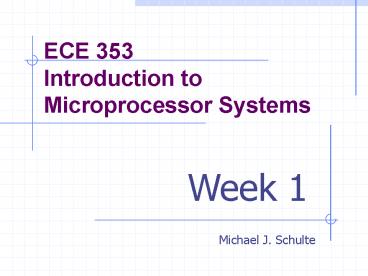ECE 353 Introduction to Microprocessor Systems - PowerPoint PPT Presentation
1 / 22
Title:
ECE 353 Introduction to Microprocessor Systems
Description:
Documentation Standards. Reference Information. Course Boot-Up. Tutorial Schedule ... Embedded microprocessors account for about 94% of all microprocessor sales. ... – PowerPoint PPT presentation
Number of Views:202
Avg rating:3.0/5.0
Title: ECE 353 Introduction to Microprocessor Systems
1
ECE 353Introduction to Microprocessor Systems
Week 1
- Michael J. Schulte
2
Topics
- Introduction
- Course Administration
- Microprocessor Systems Overview
3
Introduction
- Instructor
- Michael Schulte (schulte_at_engr.wisc.edu)
- Office Hours (4619EH)
- M, W 215-330pm
- Other times by appointment
- Teaching Assistant
- Ranjith Kumar
- Office Hours will be posted on web
4
Course Administration
- Course Objectives
- Blooms Taxonomy
- Course Schedule
- Text / Class Notes / Web Page
- Discussion Section
- Homework
- Examinations and Grading (QA)
- Documentation Standards
- Reference Information
5
Course Boot-Up
- Tutorial Schedule
- Initial Student Survey
- Complete and turn in today.
- Assignments
- Complete Solomon-Felder Learning Styles
Assessment (link on course web page) and turn in
print-out of results on Friday. - Log on to Learn_at_UW and complete first pre-quiz
before Mondays class. - Homework 1 will be due Wednesday 2/6.
6
?P Systems Overview
7
?P Systems Overview
Semiconductor Industry Association (SIA projects
1 billion transistors produced per person by
2008.)
8
?P Systems Overview
- Embedded Systems and Applications
- Embedded microprocessors account for about 94 of
all microprocessor sales. - Embedded microprocessors extend over a much
larger performance range than PCs. - Terminology
- GP Systems vs. Embedded Systems
- What are the key design parameters?
9
?P Systems Overview
- Basic microprocessor system structure
- Central processing unit (CPU)
- Memory
- Input/Output (I/O)
- System bus
- A microcontroller or SoC will include some or all
components on the same chip as the CPU.
10
Why the ARM?
- Many possible devices to study (or use!)
- Intel, Motorola, Microchip, Atmel, TI, Zilog,
Philips, Rabbit, Siemens, Hitachi, AMD, etc. - Considerations
- Installed base and software compatibility
- Development tool availability
- Complexity and architectural issues
- Computational capabilities
- Why not use the Pentium 4 instead?
11
System Design
User needs
1 Requirements Analysis
2 Specification
3 System Architecture
4 HW Design
4 SW Design
5 HW Implementation
5 SW Implementation
6 HW Testing
6 SW Testing
7 System Integration
8 System Validation
9 O M, Evolution
12
Microprocessor System Design Options
- Discrete microprocessor/microcontroller
- System-on-Chip (SoC)
- ASIC
- Programmable logic
- Soft cores
- Hard cores
- Specialized microprocessors
- Digital signal processors
- Network processors
13
Wrapping Up
- Homework 1 due Wednesday 2/6
- Reading for Week 2
- Cady Ch. 2-3
- AARM Preface, Ch. 1
- ARM7 Ch. 1
- Sign up for the tutorial!
14
Simplified Pentium 4 Architecture
15
Tutorial Schedule
Wednesday, February 13, 2007 Keil uVision3
tutorial 630-800pm EH1249
16
Blooms Taxonomy of Educational Objectives
Cognitive Domain
1. Knowledge
- Knowledge the ability to recognize or recall
information
17
Blooms Taxonomy of Educational Objectives
Cognitive Domain
2. Comprehension
1. Knowledge
- Comprehension understand the meaning of
information
18
Blooms Taxonomy of Educational Objectives
Cognitive Domain
3. Application
2. Comprehension
1. Knowledge
- Application use the information appropriately
19
Blooms Taxonomy of Educational Objectives
Cognitive Domain
4. Analysis
3. Application
2. Comprehension
1. Knowledge
- Analysis break the information into component
parts and see relationships
20
Blooms Taxonomy of Educational Objectives
Cognitive Domain
5. Synthesis
4. Analysis
3. Application
2. Comprehension
1. Knowledge
- Synthesis put the components together in a
different way to form new products or ideas
21
Blooms Taxonomy of Educational Objectives
Cognitive Domain
6. Evaluation
5. Synthesis
4. Analysis
3. Application
2. Comprehension
1. Knowledge
- Evaluation judge the worth of an idea, theory,
or opinion based on criteria
Return
22
Questions...
Midterm Exam 3
Final Exam
and answers































